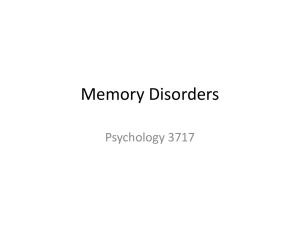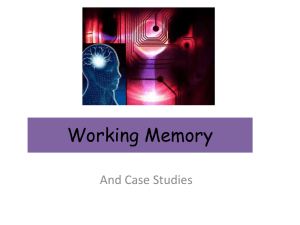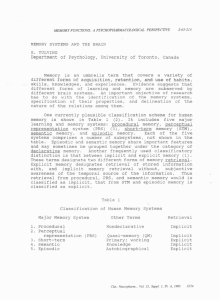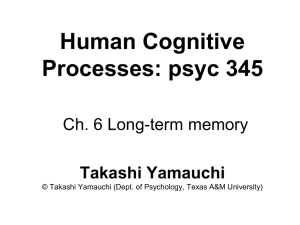Episodic and Semantic Memory
advertisement
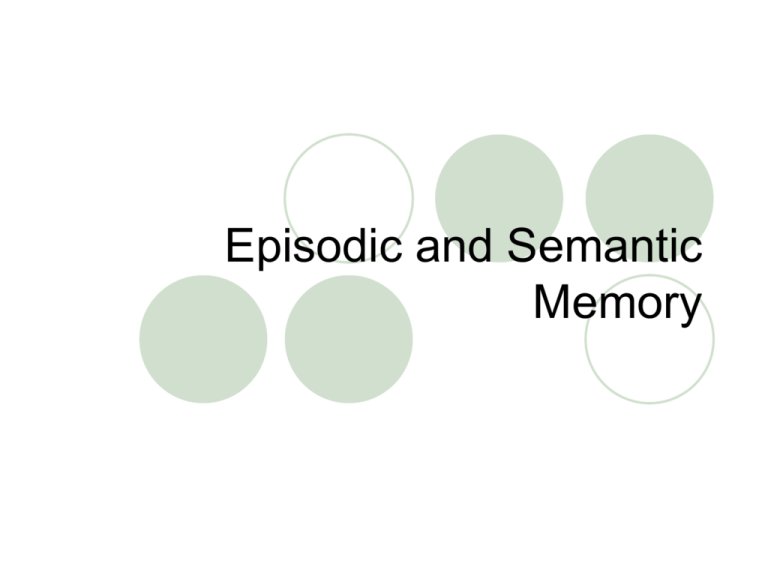
Episodic and Semantic Memory Division of LTM LTM distinctions What are the major LTM distinctions? STM vs. LTM Explicit vs. Implicit Declarative vs. non-declarative Conscious vs not conscious Episodic vs. Semantic Semantic vs. episodic memory Endel Tulving Semantic General knowledge Conceptual Less likely to be forgotten Less likely to be emotional “Is a butterfly a bird?” What are breakfast foods? Episodic Specific learned event Time-related More likely to be forgotten More likely to be emotional “butterfly” on the list? What did you have for breakfast? Episodic and semantic dissociation Difference in experience of retrieval Episodic: “mental time travel”; remember Semantic: know How do episodic and semantic memory influence each other? Episodic decays over time, retain semantic Details fade but general fact information is retained Semantic enhanced with episodic Better recall of info when associated with personal experiences Semantic influences attention & detail of episodic memory Knowledge allows for chunking Is there evidence of independent systems? Neuropsychological evidence K.C. Motorcycle accident Loss of episodic memory: no memory for events in the past nor able to create new ones Retained semantic memory: able to learn new facts (e.g. brother’s death) Italian woman Encephalitis Loss of semantic memory: unable to remember meaning of words, nor recognize familiar or famous people Intact episodic memory: able to remember events of her life; however unable to create new episodic events Clive Wearing Encephalitis Loss of episodic memory; intact semantic memory for info before illness Neuroscience evidence Levine et al. (2004) Diary on audiotape; listened to recording in scanner fMRI data suggest different areas represented for episodic vs semantic (with some overlap) Yellow = episodic; Blue = semantic; Green/red: overlap Episodic: greater prefrontal cortex Rajah & McIntosh (2005) Found similar pattern of neural interactions within each model so “episodic and semantic retrieval may reflect variation along a continuum of processing during task performance within the context of a single memory system.” Neuroscience evidence: Episodic Cabeza et al (2004) Cabeza lab http://www.cabezalab.org/projects/ episodic-memory Functional neuroimaging studies have associated episodic memory with activations in the prefrontal cortex (PFC), the medial temporal lobes (MTL), and other brain regions (for reviews, see Cabeza, 1999; Cabeza & Nyberg, 2000b; Nyberg & Cabeza, 2000). However, the specific contributions of each of these regions and their sub-regions to various episodic memory processes remain unclear. Currently, we are trying to clarify the neural correlates of two sets of episodic memory processes: relational memory and recollection, and true vs. false memories. Semantic memory research Structure: How do we represent words and word meanings in memory? Process: How do we retrieve such knowledge? Two models: Collins & Quillian (1969, 1970, 1972) Smith (Smith, Rips, & Shoben 1974) Methodology: Sentence verification task True or false: “A robin is a bird” Examine RT Independent variables: relatedness, frequency, concreteness, repetitions Sentence verification Answer as quickly as possible either true or false. A poodle is a dog. A squirrel is an animal. A flower is a rock. A carrot is a vegetable. A mango is a fruit. A petunia is a tree. A robin is a bird. A plantain is a vegetable. Coca-cola is a soda. Wofford is a college. Spartanburg is a village. Psychology is a science. Collins & Quillian Model Semantic memory network Structure Concept nodes connected by pathways Connections denote a proposition: directional relationship between concepts Category or “Is a” statement: member of a category Property statement (P): “has a” Process Spreading activation (vs. inactive baseline) Priming: Temporarily more accessible Intersection: 2 spreads of activation connect Decision stage Types of sentences to be tested Category size: A robin is a bird. vs. A robin is an animal. A dog is mammal. vs. A dog is an animal. Hyp: Faster if smaller category Typicality: A robin is a bird. vs. A penguin is a bird. Hyp: Faster if typical member False sentences: A bat is a bird vs. A pencil is a bird Hyp: Faster if “more” false Collins & Quillian (1969) Semantic memory: Methodologies Association tasks Category association Category verification tasks RT to word pairs (e.g. “robin-bird” vs “computerbird” Lexical decision tasks RT to decide if word or non-word
